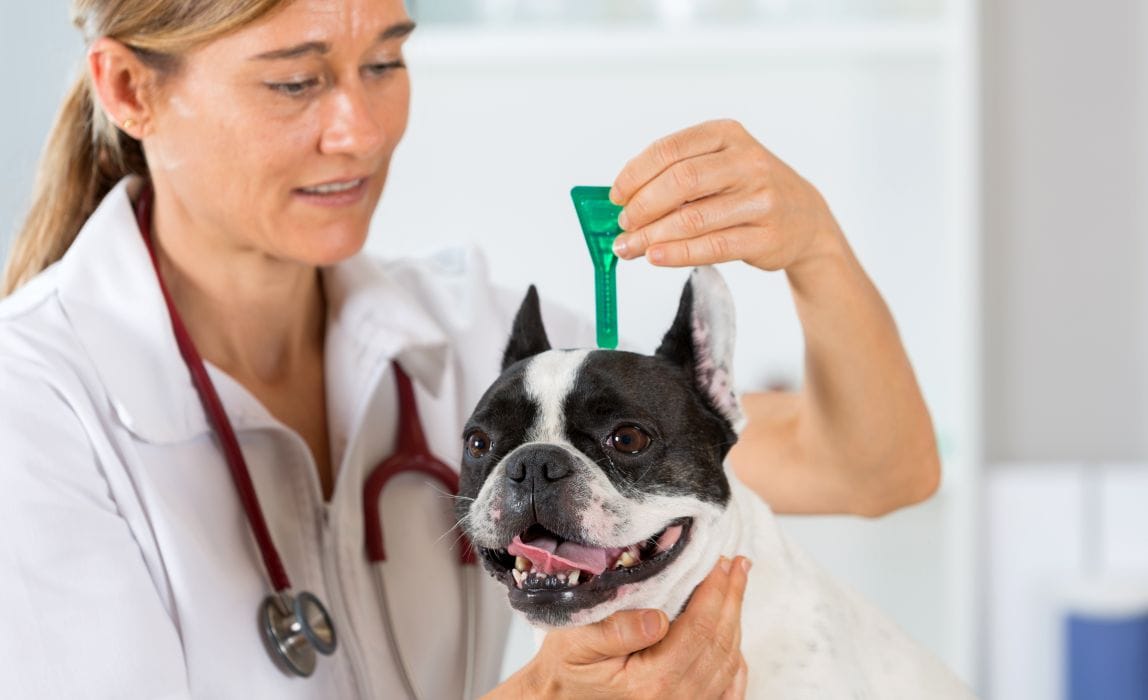The University of Ohio conducted research on modern flea control products and found several ones that proved to be very effective with dogs and cats. Learn more about these products and it’s practices, too see which one would be the best fit for your dog.
Lufenuron (Program)
Is produced by Novartis Animal Health. It offers complete flea prevention for the entire season by treating your dog monthly beginning in early spring, before the flea season starts. For dogs that live in kennels or warm climates, year-round treatment may be recommended.
The product is formulated as a pill for dogs. This flea control medication is only available from a veterinarian. It effectively sterilizes the female flea by preventing eggs from hatching. Data shows that within seven days after lufenuron is fed to the animal, virtually 100 percent of the eggs laid by female fleas failed to hatch.
Novartis Animal Health states that the product is also safe for breeding and lactating animals. All cats and dogs in a household must be treated with lufenuron because any untreated animals can infest your household with fleas.
Fipronil (Frontline)
Is a Rhone Merieux product. Frontline kills fleas for up to three months on dogs; ticks are also killed for a month or more. According to Rhone Merieux, Frontline Top Spot can be used on puppies as young as ten weeks old.
A pre-measured dosage in a plastic pipette is applied to the skin in a spot between the pet’s shoulder blades. Fipronil collects in the oil-producing glands of the skin and wicks back out with the fur for up to three months. The product is so effective that it is not removed by bathing or swimming.
Imidacloprid (Advantage)
Is produced by the Bayer company. The active ingredient in this product kills adult fleas on contact before they can lay eggs. Advantage is applied to the skin over the back, and then diffuses through the skin over the rest of the body.
The treatment works quickly; 98-100 percent of adult fleas are killed within 24 hours after application. A single dose lasts approximately one month on dogs. To prevent fleas, this product should be applied monthly. Because Advantage is not systemically absorbed, the product is considered to be very safe.
Treating the Home
Although the products listed immediately affect the fleas existing on your dog, it is important to take effective steps against the larvae living in the bedding and carpeting of your home and in any outside living quarters, if they exist.
Washing bedding in hot water and thoroughly vacuuming carpets should kill the larval fleas as well as the organic matter that the larvae feed on. There are also insecticide spray treatments that can be used to reduce the number of existing adult fleas.
Nature’s Way
Ma ny people dislike using chemical toxins of any kind on or around themselves or their dogs. A number of natural products are in use that reportedly are effective in flea control and elimination.
ny people dislike using chemical toxins of any kind on or around themselves or their dogs. A number of natural products are in use that reportedly are effective in flea control and elimination.
When ingested by a dog, brewer’s yeast gives an odor that repels fleas. Citronella is another product that has an odor that fleas dislike. Other products made from citrus oils are said to paralyze the flea’s respiratory system.
It is always best to consult a veterinarian for help in fighting the flea battle. He or she knows which products are most effective in the immediate area and they are inclined to keep abreast of new developments in combating the problem.
Fleas act as carriers of the tapeworm’s eggs. When a dog swallows a flea, the tapeworm eggs grow in the dog’s intestines.
Other exterior parasites, that you should not ignore, are:
Lice
Lice are seldom a problem with the well-cared dogs such as the Australian Cattle Dog, because the pests are spread by direct contact. In other words, to have lice your dog must spend time with another animal that has lice or be groomed with a contaminated brush or comb. Since these pests are minute in size, they are not as easy to see as fleas.
If no fleas are present and you suspect lice, the dog must be bathed with an insecticidal shampoo every week until the problem is eliminated. Fortunately, unlike fleas, lice live and breed entirely on the dog, so it is not necessary to treat the entire area in which the dog lives.
Ear Mites
Ear mites are parasites that settle in the external ear canal. They can lead to chronic irritation. Symptoms are an extremely disagreeable odor, a dark waxy secretion, and constant scratching at the ear by the dog. Once present, ear mites can be extremely persistent, particularly if a dog becomes severely infested. Flushing of the ear by a veterinarian is recommended.
Ticks
Your dog can pick up ticks by running through grass, wooded areas, or even through sand at the beach. Ticks are bloodsucking insects that bury their heads firmly into the skin. They can become a source of extreme irritation to your dog and can cause secondary infections as well.
It is important to loosen the tick’s grip before you attempt to remove it; otherwise, you may allow the head to break away from the tick and remain lodged in the dog’s skin. This also can create severe infections.
To remove adult ticks, soak them with a spray made especially for tick removal; once the parasite has loosened its grip, you can remove it with a pair of tweezers. Regular bathing with a tick dip will prevent reinfestation, but, as is the case with all dips and sprays, read the instructions carefully as some of these products may be toxic.
The entire environment in which the dog lives must be regularly and vigorously treated against ticks especially if you live adjacent to a wooded area or beach.
Ticks can transmit serious diseases that can endanger humans as well as animals. In some areas ticks carry Lyme disease and Rocky Mountain spotted fever.
It is important that you discuss the tick problem with your local veterinarian, who can advise you on which dangers might present themselves. New monthly topicals can almost eliminate the tick problem.

